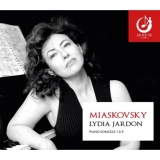Nikolai Myaskovsky (1881-1950) ist wohl am bekanntesten geworden wegen seiner Symphonien (und das durch die Aufnahmen von Yevgeny Svetlanov). Seine neun Klaviersonaten haben keine Künstler vom Bekanntheitsgrad eines Svetlanov als Fürsprecher gehabt. Aber in Lydia Jardon hat Myaskovsky eine künstlerisch eminente Interpretin. Nach einer ersten CD mit den Sonaten 2, 3 und 4 (2009 herausgekommen) folgen nun die Sonaten 1, 5 und 9. Die Nummern 1 und 5 sind Jugendwerke, entstanden, als Myaskovsky noch am Konservatorium in St. Petersburg studierte. Sie sind postromantisch, unterliegen vielem Einflüssen und sind entsprechend farbig und dramatisch. Die neunte Sonate stammt aus dem Jahre 1949. Sie ist ruhig, meditativ und sehr nach innen gekehrt.
Myaskovsky wurde als eher scheuer und introvertierter Mensch beschrieben. Mit dem Stalin-Regime hat er sich arrangiert, wurde aber dennoch auf die Liste der formalistischen Komponisten gesetzt und erst nach seinem Tode rehabilitiert.
Für Lydia Jardon lebte er in einem inneren Exil, und seine Klaviersonaten sind ihr zufolge ein Logbuch seiner Stimmungen.
Ihre Interpretationen sind sehr einfühlsam, klar und intelligent, nuancenreich und tiefschürfend. So erlangt ihr Spiel eine ansprechende Rhetorik, die die Botschaften der Musik sehr gut zum Ausdruck bringt. Ganz besonders gut gelungen ist die bewegend gespielte Neunte Sonate.
Wenn Lydia Jardon nach dieser Produktion auch die restlichen Sonaten aufnehmen würde, wäre damit die wohl beste Gesamtauflage der Myaskovsky-Sonaten auf dem Markt.
























